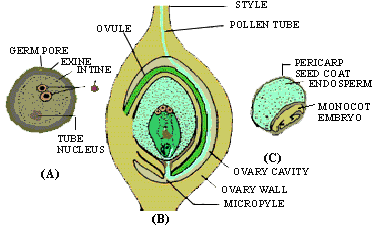|
PinkMonkey Online Study Guide-Biology
Perfect (bisexual) spikelet (Fig. 15.21C).
It is sessile and comparatively broader and larger. The axis of the spikelet
is short and bears two flowers (florets). The lower flower is sterile
and non-functional (i.e., without sex organs). The upper flower is perfect
(i.e. functional and bisexual). Each flower has two bracts; one called
the lemma and the other, the palea.
Structure of a perfect flower:
Perianth is represented by two colorless, small, broad and hairy perianth members called lodicules.
Androecium has three free stamens. Anthers are bilobed, bithecous and versatile.
Gynoecium is monocarpellary. Ovary is superior,
with one ovule in a basal placentation. There two long and free styles.
Stigmas are short and bushy.
The pedicelled staminate spikelet also has florets.
The lower one is sterile while the upper one is staminate. It has
three stamens and two lodicules, but a gynoecium is absent.
Each floret has a lemma and a palea. The spikelet is enclosed
in two glumes-outer and inner.
iii) Reproduction: Sorghum is heterosporous.
The micropores or pollen grains are produced
in the anther locules (microsporangia). Each anther locule produces many
diploid pollen mother cells. These divide by meiosis and
produce tetrads of haploid pollen grains. Young pollen grains are uninucleate.
The male gametophyte is highly reduced in size
and is produced within the microspore (pollen) wall. A fully formed male
gametophyte consists of only three cells namely a vegetative cell
and two male gametes. The mature pollen contains a 3-celled
gametophyte at the time of pollination. The pollen wall has two layers,
intine and exine. Exine is thick, smooth and has one germ
pore (Fig. 15.22A).

Figure 15.22 (A) A mature pollen grain with 3-celled male
gametophyte. (B) Longitudinal section of an ovary showing structure of
ovule
and embryo sac and passage
of pollen tube during fertilization. (C) Seed (grain) structure
|